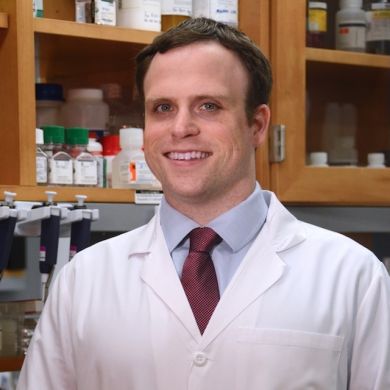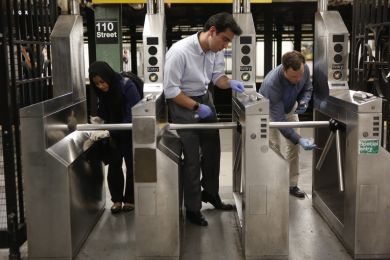The first cell inspired a career of genomic discoveries & cancer research
This article first appeared in Oncology Times. Read the original story here.
Some people struggle to find their paths in life. Not Chris Mason, Ph.D., Associate Professor and geneticist at Weill Cornell Medicine in New York City. He had already determined he wanted to be a geneticist by the time he reached eighth grade.
“I was—and still am—a curious kid. I wanted to know how the world works and how cells work. I am fascinated by the concept of ‘the first cell,’” Mason told Oncology Times.
Having come from Wisconsin and a core of Midwestern wholesomeness, Mason admits to having now added “the veneer of a fast-talking New Yorker” to his persona. Married for nine years and proud father to a 6-year-old daughter, this scientist indeed pursues life outside the demanding realm of his laboratory.
“I do other things, not just genomics, genetics, and cancer research,” he assured. “I am writing a book of poetry right now and travel whenever I can. My wife and I do a lot of scuba diving.... We like to go out with friends, of course. And we like to blend genomics and design work to make art installations.”
Joy Is in the Work
Asked if these non-vocational activities relieve the stress of rigorous research, Mason laughed. “Work for me is almost pure pleasure. Honestly, work is like a vacation to me. So if I go on vacation, it is actually a quixotic enterprise—I am taking vacation from the real vacation.”
Describing his work as one of life's great blessings, Mason returned to the theme of “the first cell” as his inspiration. “That first cell contains the recipe and the instructions for all of our cells and our human body—the physiology, the mind, the dreams, everything that we are. The mystery of our totality embedded in that first cell has been endlessly fascinating to me. It holds me in wondrous splendor; I want to unravel the mystery of it all.”
Mason's intellectual depth of inquiry required the study of genetics and biochemistry at the University of Wisconsin, followed by a Ph.D. in genome evolution from Yale University. Postdoctoral work took Mason on an unusual excursion into law.
“I met someone from Yale Law School and we started talking about ways that genetics intersects with the law. We brainstormed about embryonic stem cell research, gene editing, and questions about when life begins.... We collaborated on a course in 2005 at the law school called, ‘Law and Order: Special Genomics Unit.’ When I finished my Ph.D. in 2006, one of the opportunities was to do a dual postdoctoral fellowship—one at the medical school in normal neuro-genetics postdoc work, and the other at the law school working on genetics and intellectual property.”
Genetics Goes to Court
This intersection of law and genetics all served to guide Mason to a rare—and historic—experience. “I worked on [a] gene patent case that ended up before the U.S. Supreme Court,” said Mason. He served as an expert witness against a company that had claimed patent entitlement to the stunningly important BRCA1 and BRCA2 cancer genes. The company had earlier discovered the location and genetic sequence of the genes.
“What started as a research project during my fellowship snowballed, with effort from a lot of other people, into the whole case,” Mason recalled. “It just seemed so fundamentally wrong to me that I couldn't take DNA out of my own genome—it was no longer my property—because of the patent. How did that happen? It was an injustice that needed to be addressed. I wrote two declarations and trained the lawyers in the basic genetics behind the case from 2007 to 2013.”
In 2013, the Supreme Court held (9-0) that a naturally occurring DNA segment is a product of nature and not patent-eligible and it invalidated the patent claim on the BRCA genes. “It was thrilling,” said Mason. “I was so lucky to be able to stand up against something I believed to be wrong, have it addressed, see it go to the Supreme Court, and ultimately corrected. Clearly, it was one of the most amazing experiences of my life.”
Work in the Mason Lab
The website for The Mason Lab offers tantalizing insight into some of the work that Mason and his team are doing now.
“We aim to use and improve technological methods in molecular genetics, so we can more accurately map the molecular networks of the genome and their changes over time,” Mason explained.
“We leverage clinical cases that can reveal the most about the human genome: the most peculiar cases in human genetics, the most aggressive cancers, and the most striking brain malformations...”
Asked to pinpoint some of “most peculiar cases” referred to on the website, Mason was quick to respond. “We worked with people who were near the nuclear reactor at Chernobyl—people who have been through extreme exposures. Our Chernobyl work included examining thyroid cancer in children. Thyroid has very specific age range in which it is sensitive to radiation—6-12. At older ages, most of the thyroid cells have been formalized and locked down. We found the risk for radiation damage to be time-specific. We also found that, if a person does get cancer from their proximity to Chernobyl, the cancer is continuously evolving.”
A recent paper by Mason and team explored and identified the independent evolutionary trajectories of genomes and epigenomes in acute myeloid leukemia (AML).
Mason simplified the resultant understanding. “That fact that mutations lead to cancer is something we've known for a long time. But what has only been appreciated in the past few years is the understanding that there are others ways, more subtle chemical changes—epigenetic changes—and slight modifications of the letters in a genetic code that can cause a site to change and evolve and become more aggressive independent of the mutation,” he noted.
“It's as if you are walking down a road, and cancer is able to take some kind of shortcut path to make cells do what they should not do. Many had thought there was only one way to shortcut the cell and avoid the normal ways cells get regulated, but now we've found a second way that can do this, another path. There has been some evidence of this dysregulation for about 10 years. But until this work, we did not know the specific sites that were really changing in AML or cancer in general.”
Genetics & Epigenetics
The Mason Lab is now about 4 years into its project on understanding the genetics and epigenetics of cancer. But how does the understanding of changes and subtle changes inform clinical care? Where is the clinical relevance?
“We have already done some work in monitoring patients as they are getting treated, so we think this work is already clinically relevant and will continue to be relevant for leukemias, breast cancers, and colon cancer soon, if not immediately,” assured Mason.
Asked how one monitors a patient for epigenetic changes, he explained, “It is chemical process we call bisulfite sequencing. We take cells from a patient, treat those cells, and discern with a sequencing assay all of the locations that have changed. It is almost like reading the book of life. You can read each one of the genetic changes and epigenetic changes in the cancer sample through next generation sequencing. When we see the changes, we can now use CRISPR technology to genetically modify the locations.”
Mason said, even though CRISPR technology was discovered 30 years ago, it has only been applied to biological systems in the past 2-3 years. (The use of CRISPR for genome editing was the American Association for the Advancement of Science's choice for breakthrough of the year in 2015.)
“What we have been doing, now for the first time ever, is modifying specific locations in the genome and the epigenome. We can find all the places in the patient where harmful changes have occurred and revert them back to how they were before those changes took place. For people in my field, it is a time of euphoria,” Mason proclaimed. “All of the things I fantasized about when I was a child—viewing, studying, and editing the human genome much like viewing, reading, and editing a Word document—we can do today. And it is extraordinary. It is an awesome time to be a geneticist.”
If there is a primary message Mason would want to deliver to oncologists, it is this: “I implore you to realize that the cancer you are treating is evolving at multiple layers within cells, and often independently. In some layers you may see no change, and there may be many changes in a different biological layer. Therefore, you must become aware of treatment options that span different regulatory realms.”
As for his continuing bent for “peculiar” undertakings, Mason is now a principal investigator on the NASA Twins Project, examining the impact of long-term space travel on the human body at genetic and epigenetic levels. “We haven't published this yet, but I can tell you that we have seen many molecular changes that affect the body and might persist long-term. We are looking at the data as I speak,” Mason divulged. “There have only been 450 people who have left Earth and come back. A lot are still alive, and we don't know if they will get cancer. But we know changes occur and how long they persist. It will take time to see if cancer develops.”
Every day continues to be an adventure for the grown-up eighth grader with a dream of discovery. Indeed, he took the right career path.
Dust off
Shake hands, take off your shirt,
clap at a concert, fan your hot food, or flirt,
and every time that you do,
you lather the world with you,
millions of you -
but you are not alone.
Take your 160 dead skin cells per second
shooting through the air
and add
32 million bacteria per square inch of skin,
living unmarried, in sin, among all your hair,
then add
600 haploid plant genomes per square inch of skin,
jobless, vagabond pollen, under all you wear.
Gather all your genomes together:
haploid and diploid,
happenstance and determined,
linear and circular,
languid and catalytic,
and go take a shower.
Clear the grounds.
There will be new visitors soon.




